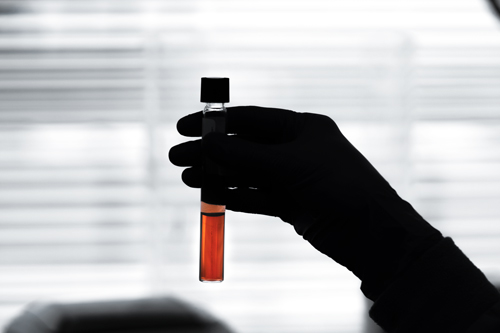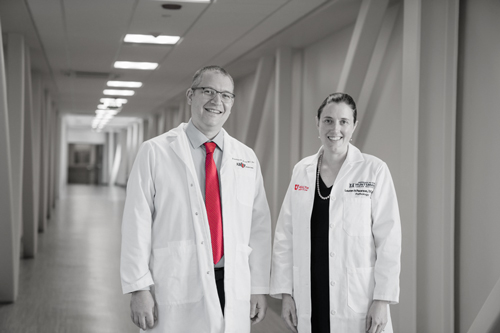
ARUP Associate Medical Director Steven Baker, MD, PhD, will lead research that aims to determine whether gene therapies can be developed to treat patients living with creatine transporter deficiency (CTD).
For parents of a child with a rare disease, there are few joys greater than finally receiving a definitive diagnosis. That joy, however, diminishes when they learn that there are no proven treatments for their child’s disorder.
An initiative underway at ARUP Laboratories and the University of Utah seeks to change that for one rare inherited disease, drawing on the expertise of two pioneers in the diagnosis and treatment of cerebral creatine deficiency syndromes (CCDSs) and the ideas of two pathologists who are newer to ARUP. With the funding support of the Association for Creatine Deficiencies (ACD), the initiative seeks to discover new diagnostic tools and gene therapies to treat creatine transporter deficiency (CTD), one of three CCDSs that affect the central nervous system and can result in intellectual disability, autistic behavior, and epilepsy.
If everything goes as planned, the team envisions creation of a formal Center of Excellence led by Marzia Pasquali, PhD, FACMG, section chief of ARUP’s Biochemical Genetics department, and Nicola Longo, MD, PhD, a pediatric medical geneticist, chief of the Medical Genetics division at University of Utah Health, and a member of Biochemical Genetics at ARUP. They are joined by Steven Baker, MD, PhD, an associate medical director of Transfusion Medicine at ARUP since July 2021, who also does basic science research at the U, and Filippo Ingoglia, PhD, ARUP medical director of Biochemical Genetics since March 2022.
“We have the perfect situation at ARUP and the University of Utah to make this happen,” said Heidi Wallis, executive director of ACD and the mother of two children with guanidinoacetate methyltransferase (GAMT) deficiency, another of the three CCDSs.
Pasquali and Longo are known for their work in the diagnosis and treatment of GAMT deficiency. Along with Wallis, they were instrumental in getting the metabolic disorder added to Utah’s newborn screening panel in 2015. More recently, their efforts also got GAMT deficiency added to the federal Recommended Uniform Screening Panel, a milestone that will lead many more states to add it to their screening panels. GAMT deficiency is treatable with supplements and a restricted diet when diagnosed in infancy.
All three syndromes are rare, and they’re also underdiagnosed, but among patients identified as having one of the CCDSs, CTD is most common, accounting for 72% of cases, Baker said, citing research published in Human Genetics.1,2 It is the only syndrome of the three for which there is no proven therapy, which is why the initiative focused on CTD is important, he said.
CTD is caused by an SLC6A8 gene variant, which prevents the transport of creatine across the plasma membrane. Creatine is particularly critical for cells in the brain and muscles, according to the National Organization for Rare Disorders. Without creatine, the high energy levels necessary for brain and muscle function cannot be sustained.
Individuals with GAMT deficiency or L-arginine:glycine amidinotransferase (AGAT) deficiency, the third of the CCDSs, do not have enough of either GAMT or AGAT enzymes necessary to form creatine, but they can take supplements to compensate for what their bodies can’t produce. In contrast, individuals with CTD produce creatine, but the creatine transporter does not function properly, so they have creatine in their bloodstreams but not enough in their muscles and brains.
Research projects on which the CTD initiative is embarking seek to help those diagnosed with CTD in a number of ways.

Ingoglia is working to develop a test that uses mass spectrometry technology to measure the creatine transport activity to determine whether any creatine at all is transported into cells (fibroblasts and possibly blood cells) of an individual with the disorder. If this information were available, it would be possible to identify patients with residual transport activity who could derive at least some benefit from creatine supplementation.
The premise of Baker’s research is that patients with CTD suffer from a failure of neurons to take up creatine from neighboring cells (oligodendrocytes). Research expected to begin in the summer of 2023 in his lab will test whether it is possible to use either gene therapy or gene editing with clustered regularly interspaced short palindromic repeats (CRISPR) to induce expression of the enzyme AGAT in neurons. The hope is that this would permit the internal synthesis of creatine in the neurons themselves.
“If we are able to do this safely and effectively, it would pave the way for development of a treatment for patients with CTD, but we need to test it first,” Baker said.
For her part, Pasquali is continuing to work to validate a screening method for CTD.
Wallis said the initiative aligns well with ACD’s goal to support and help fund academic and industry research that aims to improve the lives of individuals with CCDSs. The association has earned grants from sources such as the Chan Zuckerberg Initiative and the Patient-Centered Outcomes Research Institute, but most of its funding comes from individual donors or is raised through events such as an annual walkathon.
The ACD’s funding support is invaluable in helping to get research off the ground so that investigators can get to work collecting preliminary data that may enable them to obtain additional funding for their work, Pasquali and Longo said.
They are enthusiastic about the initiative and the potential it has to develop into a formal Center of Excellence.
“We’re very fortunate that we have a confluence of skills and interest here at ARUP and the U to pursue this project,” Baker added.
Wallis agreed. “There is a brain trust at ARUP and the U that we believe will be instrumental in finding therapies for CTD and other CCDSs,” she said. “We are just getting started and hope to attract more researchers to work on this problem with us. I believe that the future looks bright for families affected by CCDSs.”
Lisa Carricaburu, lisa.carricaburu@aruplab.com
1. Stenson PD, et al. The Human Gene Mutation Database (HGMD®): optimizing its use in a clinical diagnostic or research setting. Hum Genet. 2020;139(10):1197–1207.
2. Mercimek-Andrews S, Salomons GS. Creatine deficiency disorders. In: Adam MP, et al, eds. GeneReviews. University of Washington, Seattle; 2009.
















